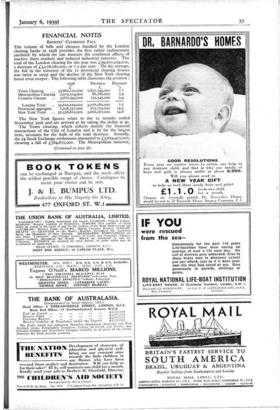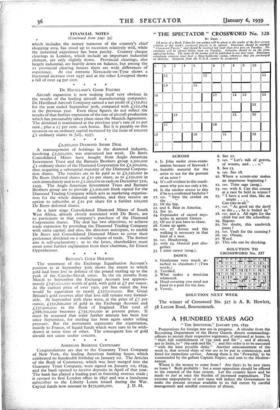FINANCIAL NOTES BANKERS' CLEARINGS FALL
THE volume of bills and cheques handled by the London clearing banks in 1938 provides the first rather rudimentary yardstick by which we can measure the combined effects of inactive share markets and reduced industrial turnover. The total of the London clearing for the year was £39,610,229,000, a decrease of £3,076,080,000, or 7.2 per cent. On the average, the fall in the turnover of the 11 provincial clearing houses was twice as steep and the decline of the New York clearing house even steeper. The following table illustrates the position :
1938 Decrease Decrease
(1/, Town Clearing ..
33,862,122,000
2,857,349,000 7.7
Metropolitan Clearing
2,075,514,000
86, x86,000
3.9 Country Cheque ..
3,672,593,000
132,545,000 3.4 London Total .. 39,610,229,000 3,076,080,000
7.2
Provincial aggregate
New York Total ..
1,258,2373000
32,556,815,000
213,752,000
5,666,267,000
14.5 14.8 The New York figures relate to the 12 months ended November 3oth and are arrived at by taking the dollar at 4s.
The Town clearing, which reflects mainly the financial transactions of the City of London and is by far the largest item, accounts for the bulk of the total decrease. Actually, the 24 Stock Exchange settlements amounted to £3,659,472,000, showing a fall of £584,872,000. The Metropolitan turnover,
(Continued on page 36) FINANCIAL NOTES (Continued from page 35) which includes the money turnover of the country's chief shopping area, has stood up to recession relatively well, while the industrial experience has been patchy. Country cheque clearings in London, which include an important industrial element, are only slightly down. Provincial clearings, also largely industrial, are heavily down on balance, but among the II provincial clearing houses there are wide differences of experience. At one extreme Newcastle-on-Tyne shows a fractional increase over 1937 and at the other Liverpool shows a fall of over 24 per cent.











































 Previous page
Previous page